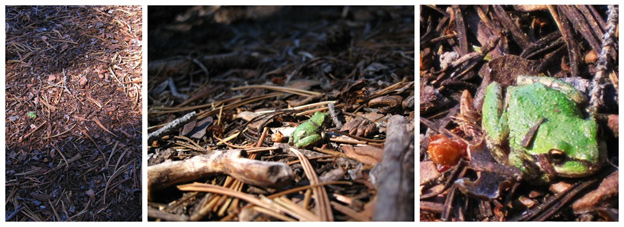One such creature is the Pacific tree frog. It is found along the Pacific coast from British Columbia all the way down to the Baja Peninsula. Here in the park they are found at all elevations, in many kinds of habitats. If you are hiking a meadow, woodland, or brushy area it may be easier to identify the Pacific tree frog by listening. The males make a call that sounds like "krr-r-r-ek". During mating season the sound of one male frog will stimulate other males to join in, and produces a chorus of frog calls. They breed in water: ponds, lakes, slow moving streams, and seasonal pools, but they are often found roaming the surrounding uplands, several yards from the water. Special glands help the frogs produce a waxy coating that allows them to stay moist. To avoid drying out they will spend time in the shade of vegetation, rocks, logs, and other protected spaces.

Can you spot the Pacific tree frog in all three photos?
This little guy was spotted not too long ago while hiking around Lukens Lake. For some people it is just as exciting to see one of these amphibians as it is to encounter a bear (well, almost as exciting)! Although the Pacific tree frog is not a rare species in the park, they are often overlooked; at a whopping ¾-2 inches in length, it isn't difficult to see why. If you are lucky enough to come across a Pacific tree frog while hiking, a telltale characteristic is a black stripe traveling from the tip of their nose, across the eye, toward their shoulder. And while I don't normally recommend travelling while looking down, every now and then it doesn't hurt, in order to recognize the little things that call Yosemite home.
